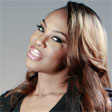All About Cosmetology Mannequin Heads
ALL ABOUT COSMETOLOGY MANNEQUIN HEADS
If you are shopping for a cosmetology mannequin head for the first time, chances are you’ll find the experience a bit confusing.
Whether you need a mannequin for a cutting class, a state board exam, a competition or simply to learn hair styling techniques on your own, you need to make sure you get what you pay for.
In this tutorial we help you better understand how mannequins are made and what attributes make the prices vary so much.
You can watch the 3 videos for detailed information on the following topics:
Video 1: We look at the different type of hair, as well as hair quality.
Video 2: I talk about hair length, density, layering and types of implants.
Video 3: I talk about the different kind of mannequin heads and holding stands.
PART 1. TYPES OF HAIR AND HAIR QUALITY
The bulk of the cost of a cosmetology mannequin is driven by the cost of hair.
There are 3 different types of hair used for mannequins: human hair, animal hair and synthetic hair.
HUMAN HAIR
Human hair for mannequins comes mainly from Asia with China, India and Korea being the most common sources. European hair is also used but since it’s more expensive you will find mostly on premium quality mannequins. Some people believe that human hair for trade comes from dead corpses; they do not. Hair trade is a popular and lucrative activity in Asia. Some people sell their hair to generate revenue, whereas others may donate their hair for religious reasons. Hair trade is a whole subject on its own and goes beyond the purpose of this tutorial, but at least it is helpful to know where the majority of the human hair for mannequins comes from.
Human hair is classified into different quality categories. When it comes to cosmetology mannequins, we will focus on the most important three quality categories, they are: processed hair, virgin hair and Remy hair. To better understand these classifications, let’s look at the biology of a human hair.
Hair is mainly composed of proteins that are organized into three structures. The outside part of the hair is called the cuticle. It is made of several layers, which grows in the same direction from the root to the tip of the hair. All the layers are stacked on each other, just like the shingles on a roof. The cuticle protects the inside part of the hair.
The inside part of the hair is called the cortex and is made of long protein fibers giving the hair its strength. The cortex is also where the pigments of melanin are found, which is what gives the hair a specific color.
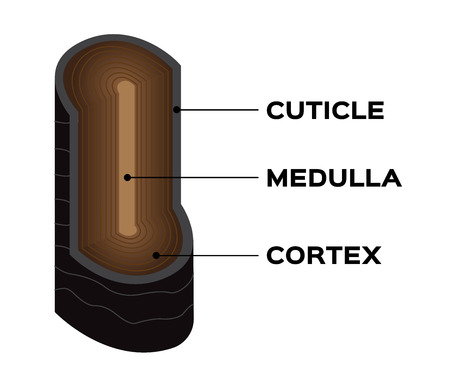
The third and most inner part of the hair is called the medulla. It is a small and hollow space inside the cortex and not present in all hair fibers.
PROCESSED HAIR
Processed hair, or sometimes referred to as “tangle-free” hair, is the most common and economical type of human hair used for mannequins. Hair is collected into large containers, where it is sanitized. Since the hair has not been kept in alignment (or in other words, all the roots and tips are mixed up), the cuticles are not facing the same direction. If they were kept like that, the hair would easily tangle. To resolve this problem, the hair cuticles are removed using an acid. This eliminates the friction and allows for tangle free brushing of the hair. Processed hair is also typically sold as a uniform color, so the hair is dyed to achieve a specific color level.
Finally, without its cuticle the hair would look dull and brittle. To re-create the appearance of healthy and shiny hair, a laminate product is also added. You can think of this laminate as a replacement for the cuticle.
So in a nutshell this is what how processed human hair is made.
Now here are a few things to note about processed hair:
- Since the cortex is still present, the hair can be colored or permed.
- Because the cuticle has been removed, it will be more difficult to give volume.
- The laminate that was used to replace the cuticle is not as tolerant to heat than the natural human hair cuticle. So processed hair should be curled or flat ironed at lower heat settings.
- This laminate also won’t last forever, especially if the hair is chemically treated with a dye or a perm. After several uses, your mannequin’s hair will become more fragile.
VIRGIN HAIR
Virgin hair means that the hair has not been colored or permed. Virgin hair is usually made with a higher quality of hair but it is possible that it too had its cuticle removed, similar to processed hair.
Virgin hair is better used for coloring classes because the hair cortex is all natural and has not been damaged by any prior treatments.
REMY (OR REMI) HAIR
Remy is the term used to designate the highest grade of quality for human hair. Remy hair has retained the cuticles in proper alignment. If the hair has not been colored, it is sometimes also referred to as “Virgin Remy”.
Mannequins made with Remy hair can be quite expensive and is often used by hair coloring educators in trade shows or other educational settings to make sure their coloring product will produce optimal results.
It is the closest thing to working with an actual person.
ANIMAL HAIR
Some mannequins are totally or partially made with animal hair. The most common animals used are horse, camel and yak. These mannequins will either be less expensive, or as a trade-off have a higher hair density. This can be a great alternative if you only need the mannequin for styling and cutting. Animal hair does not react the same way to chemicals than human hair, so it is not recommended for hair coloring or any other chemical processes.
SYNTHETIC HAIR
Mannequins with synthetic hair are a lot cheaper than the ones with human hair. Most synthetic hair will not tolerate heat, so these mannequins are usually recommended for braiding, cutting or styling without the use of heated tools.
Because of its lower cost, synthetic hair mannequins usually have very long hair.
HAIR BLENDS
Synthetic, animal and human hair are sometimes blended together to lower the cost of mannequins. Reputable vendors will disclose the ratio of human hair vs. synthetic hair composition. Unfortunately some vendors fail to disclose the hair composition or ratios, sometimes even concealing the fact that a mannequin may contain animal or synthetic hair blended with human hair. Since it can be difficult to inspect your mannequin to find out what the hair is really made of, don’t be afraid to ask questions ahead of time.
As a general rule, if the mannequin is described as 100% human hair, that’s what it is.
If it only says “Human Hair” without a percentage, this most likely means it’s some type a blend.
PART 2. HAIR LENGTH, LAYERING & DENSITY
Cosmetology mannequin heads can be quite expensive, and you may find it difficult to figure out what makes the price vary between one model and another. In the previous section, we discussed hair types and quality levels. The type and quality of hair is the first factor that impacts the cost of a mannequin. The second most important cost factor is the hair length. Since hair length is such an important factor in pricing a mannequin, it is important to understand how they are measured. Not everyone measures the same way.
HAIR LENGTH
Hair length is typically measured from crown to ends. The crown is located on the top of the head, toward the back. By placing your measuring tape on the crown and dragging it down all the way to the tip of the hair in the back, you get the overall crown to ends measure.
The second most popular way to measure hair is from the hairline (at the forehead), down to ends. There is about 3 inches length between the hairline and the crown, so it’s important to find out how the vendor measures the hair.
The crown to ends method is widely used and accepted, so naturally it is also the most common.
Now length alone is not enough to understand what you are getting, because hair is often layered.
LAYERS
Almost all mannequins have layered hair. A layered hairstyle simply means that shorter hair is blended in with longer hair. If you look at the following illustration, you see that hair from the top do not necessarily extend all the way to the bottom.
If a mannequin is made with hair grafts of the same length all around the head, you end up with dramatic layers around the whole head. So typically the mannequin is made with longer hair at the top and shorter hair in the back and at the nape.
This produces a more natural layering effect. If you find a mannequin that is described as “one length”, it means there are no layers. These hairstyles are also referred to as a “blunt cut”. Non-layered mannequins are not common.
The last thing about layers that’s common with mannequins is the mixing of short and long hair across the head. As you can see on this diagram, different hair lengths are mixed in. This reduces the cost of the mannequin without compromising the overall hair length. This is also very common with most cosmetology mannequins.
DENSITY
Hair density is the final factor that will impact the cost of your mannequin. Density is determined by how close each graft of hair is implanted next to each other. Cheaper mannequins usually have a lower hair density. For a hair cutting class you may not want to spend the extra dollars for higher density. However once you get into more advanced styles, or updos, the extra hair density may become important.
IMPLANTS
Typically, hair grafts are implanted at a 90-degree angle, or angled toward the back. This is not how human hair grows naturally, so you will also find some mannequins that mimic natural human hair growth pattern. They are especially important for bob cuts, which requires the bangs to fall forward.
You can easily distinguish between the two by looking at the hairline. Standard implants are coming straight up and natural implants are coming down and to the side.
PART 3: TYPES OF MANNEQUIN HEADS AND THEIR USE + MANNEQUIN STANDS.
“MANIKIN” VS “MANNEQUIN”
You may have noticed that the word “mannequin” or “manikin” is not always spelled the same way. Both spelling are correct. The “manikin” spelling is typically used for medical or anatomical dummies. The “mannequin” spelling is typical of display dummies such as those you see in the window of a clothing store. Mannequin heads kind of fall in between these two definitions so this is why we find them spelled both ways.
So if you search online for information on mannequin heads I recommend doing your search using both spelling to get more results.
TYPES OF MANNEQUIN HEADS
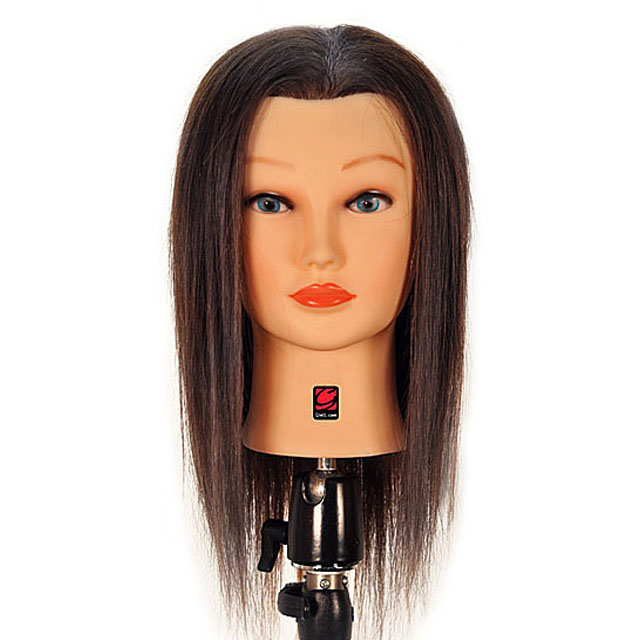
You may also have noticed that mannequins have a name. As an example, one of our popular mannequins at Giell is named Joanne. It is part of our house brand of mannequin heads (Giell).
The outside of cosmetology mannequins is made of rubber and the inside is filled with polyurethane. The hair is permanently attached to the head. Light makeup is painted on the face as well as eyes and brows. The head is about 12 inches tall and has a circumference of about 21 inches. This is slightly smaller than an actual human head.
The standard, medium length, human hair, female mannequin head is the most typical type of mannequins on the market.
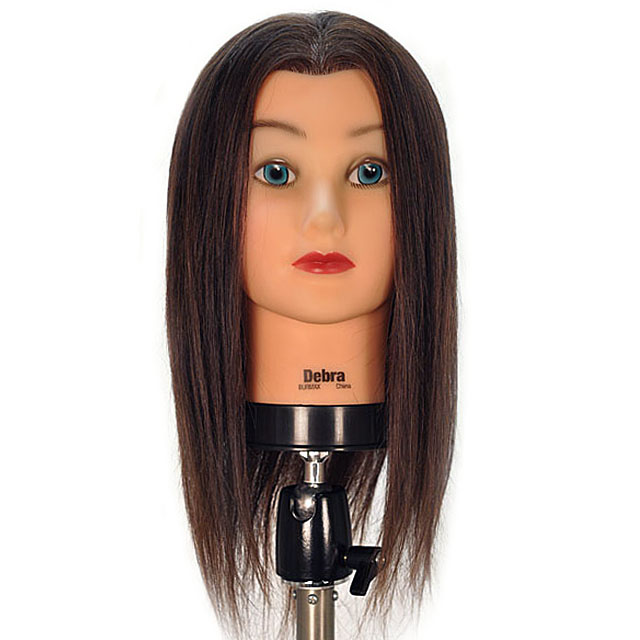
Another example of a standard mannequin head is the model Debra from Celebrity. Celebrity is another brand of mannequins we carry at Giell.com. The main difference is that Joanne has a natural neck design, whereas Debra has a plastic band at the neck. Other than that, they are essentially made the same way.
Another type is called a “slip-on” mannequin head. The bottom mannequin serves as a holder for the hairpiece, which looks somewhat like a mask. Although you may think that these would be cheaper, they are not. That is because they are not as popular, and also because the majority of the cost is derived from the hair and labor.
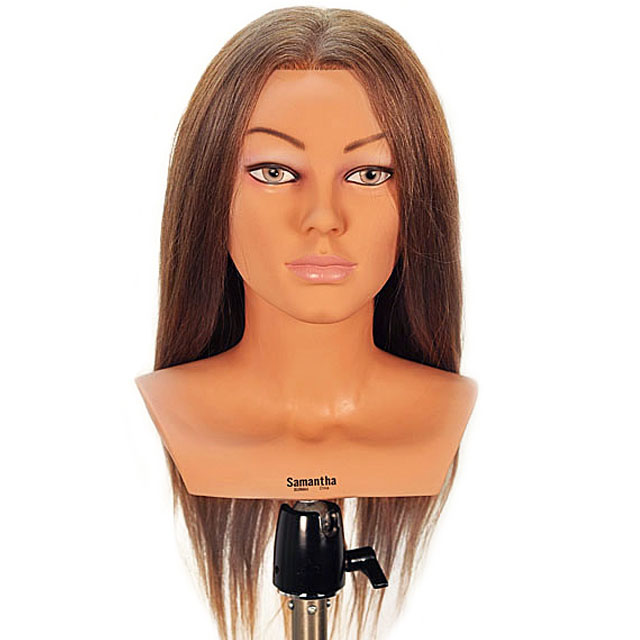
There are mannequin heads with a shoulder base. These are mostly used for competitions and stand nicely on their own. Some of them have pierced ears so you can install earrings if you want.
Mannequins come in male and female versions, as well as different ethnicities. Some male mannequins have a beard and these are used in barbering school. Male mannequins are also slightly larger than the female ones.
Ethnic mannequins are offered with curled and straight hair. It is important to know that these mannequins were also made with Asian hair so the curled mannequins have been chemically permed.
Another type of mannequin heads is called a “Quad”. It has four different hair colors and is used for hair coloring. One of the four quadrants usually has gray hair.
Miniature mannequins have appeared in recent years. They are not as popular but they can serve a purpose. They can be made with human hair; they are just smaller. Be aware when you shop to look at measurements, as the mini mannequins can look exactly like the larger ones on a photo.
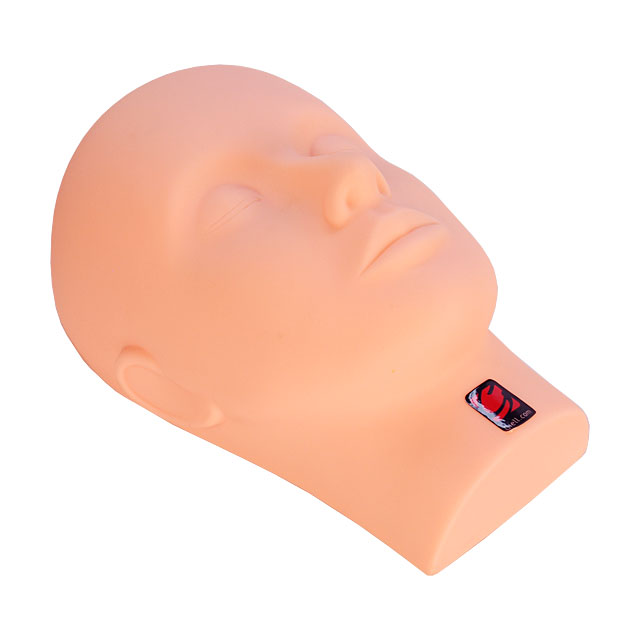
Not all mannequins come with hair. One for example can be used to practice makeup, facials, massage and eyelash extension training. It is made with a different kind of rubber that is softer and feels more like facial skin. It also has a flat back so you can work with it on a table. Another one has no hair at all. It can be used with wigs but also for display purposes, or photographic and cranial studies.
MANNEQUIN STANDS AND HOLDERS
All cosmetology mannequin heads have a hole at the base, which mounts on a stand.
There are two types of stands: table clamps and floor tripods.
Table clamps are inexpensive and comes in a variety of materials and length. You would typically use a regular clamp with short hair mannequins, and the longer version for long hair mannequins. Some clamps come with extenders so you can adjust the length. Other, like this one for example, has a long rod that can be adjusted to various lengths.
Every stand is adjustable so you can tilt the head in any direction.
Floor tripods are definitely more convenient; especially in a classroom or trade show setting. You can setup your work are anywhere you want.
These are the two major different types of tripods, where one has small legs at the base, and a center pole, which is adjustable. The second type has legs extending from the top to the floor. In that case, each leg is adjustable. The advantage of the first type is that it occupies a smaller footprint. That can be convenient if you don’t have a lot of room to work around. The other type, when the legs are fully extended, has a much larger footprint. Because of this it will be more stable.
Both of these are quite sturdy and made to last. They are either made of aluminum alloys or light steel. Tripods also come with carrying bags.
Be aware that some tripods are made with modified camera tripods. They are appealing because of the lower price, but they are too light to serve their purpose. They are often made with several plastic parts, and you will only end up throwing them away and buying the real deal.
By know you should have learned all the important factors about cosmetology mannequin heads and stands. I hope the information will be helpful in guiding you through your buying decision process.


















